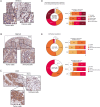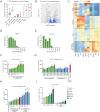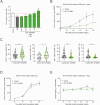Targeting the aryl hydrocarbon receptor (AhR) with BAY 2416964: a selective small molecule inhibitor for cancer immunotherapy
- PMID: 37963637
- PMCID: PMC10649913
- DOI: 10.1136/jitc-2023-007495
Targeting the aryl hydrocarbon receptor (AhR) with BAY 2416964: a selective small molecule inhibitor for cancer immunotherapy
Abstract
Background: The metabolism of tryptophan to kynurenines (KYN) by indoleamine-2,3-dioxygenase or tryptophan-2,3-dioxygenase is a key pathway of constitutive and adaptive tumor immune resistance. The immunosuppressive effects of KYN in the tumor microenvironment are predominantly mediated by the aryl hydrocarbon receptor (AhR), a cytosolic transcription factor that broadly suppresses immune cell function. Inhibition of AhR thus offers an antitumor therapy opportunity via restoration of immune system functions.
Methods: The expression of AhR was evaluated in tissue microarrays of head and neck squamous cell carcinoma (HNSCC), non-small cell lung cancer (NSCLC) and colorectal cancer (CRC). A structure class of inhibitors that block AhR activation by exogenous and endogenous ligands was identified, and further optimized, using a cellular screening cascade. The antagonistic properties of the selected AhR inhibitor candidate BAY 2416964 were determined using transactivation assays. Nuclear translocation, target engagement and the effect of BAY 2416964 on agonist-induced AhR activation were assessed in human and mouse cancer cells. The immunostimulatory properties on gene and cytokine expression were examined in human immune cell subsets. The in vivo efficacy of BAY 2416964 was tested in the syngeneic ovalbumin-expressing B16F10 melanoma model in mice. Coculture of human H1299 NSCLC cells, primary peripheral blood mononuclear cells and fibroblasts mimicking the human stromal-tumor microenvironment was used to assess the effects of AhR inhibition on human immune cells. Furthermore, tumor spheroids cocultured with tumor antigen-specific MART-1 T cells were used to study the antigen-specific cytotoxic T cell responses. The data were analyzed statistically using linear models.
Results: AhR expression was observed in tumor cells and tumor-infiltrating immune cells in HNSCC, NSCLC and CRC. BAY 2416964 potently and selectively inhibited AhR activation induced by either exogenous or endogenous AhR ligands. In vitro, BAY 2416964 restored immune cell function in human and mouse cells, and furthermore enhanced antigen-specific cytotoxic T cell responses and killing of tumor spheroids. In vivo, oral application with BAY 2416964 was well tolerated, induced a proinflammatory tumor microenvironment, and demonstrated antitumor efficacy in a syngeneic cancer model in mice.
Conclusions: These findings identify AhR inhibition as a novel therapeutic approach to overcome immune resistance in various types of cancers.
Keywords: Drug Evaluation, Preclinical; Immune Checkpoint Inhibitors; Immunotherapy; Indoleamine-Pyrrole 2,3,-Dioxygenase; Metabolic Networks and Pathways.
© Author(s) (or their employer(s)) 2023. Re-use permitted under CC BY-NC. No commercial re-use. See rights and permissions. Published by BMJ.
Conflict of interest statement
Competing interests: CK, NS, LR, UR, BB, DS, FP, MG, HGR, CO, GL, HI, RL, JL, MO-W, RC, HW, IVH, BK and IG are current or former employees of Bayer. NS, UR, BB, MG, GL, HI, RL, JL, FC, DB, CAO, HW, IVH and IG are stockholders of Bayer AG. CK, NS, LR, UR, BB, DS, HI, RC, MP and IG hold patents connected to this work.AS and CAO are founders and managing directors of cAHRmeleon Bioscience GmbH. Some of the authors have patents on AHR inhibitors in cancer (WO2013034685, MP; CAO); A method to multiplex tryptophan and its metabolites (WO2017072368, MP, CAO); A transcriptional signature to determine AHR activity (WO2020201825, AS, CAO); Interleukin-4-induced gene 1 (IL4I1) as a biomarker (WO2020208190, AS,CAO); Interleukin-4-induced gene 1 (IL4I1) and its metabolites as biomarkers for cancer (WO2021116357, AS, CAO).No disclosures were reported by the other authors.
Figures





References
Publication types
MeSH terms
Substances
LinkOut - more resources
Full Text Sources
Medical
Research Materials
